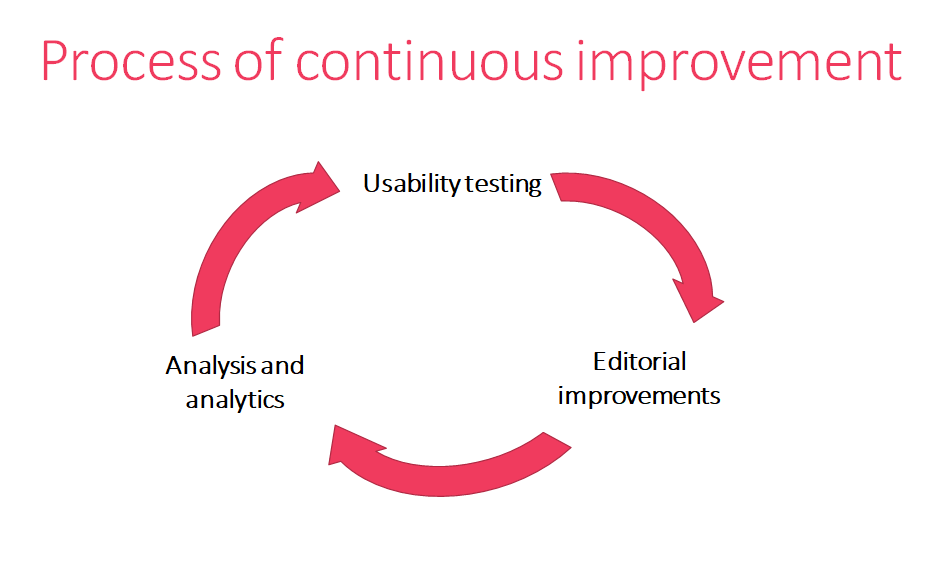Today’s guest post is provided by Lauren Tormey who, together with Duncan MacGruer, will facilitate a workshop session on “You’ve Got (Too Much) Mail: Encouraging Self-Service Through Improving Content” at the IWMW 2018 event.
Helping our users to help themselves
How many emails do you receive where you think to yourself, why is this person contacting me when the answer is on our website?
At the University of Edinburgh, we’ve been working to cut down the number of IT-related enquiries that come in where users could self-serve by reading our web pages, and we’ve been doing this by following a process of iteratively testing and improving our content.
The challenge
For the past two years, we’ve been working with the University’s Helpline service who field the vast majority of initial enquiries from staff and students. Helpline deal with 7,000-10,000 support calls a month, which includes enquiries on topics users can resolve themselves by following guidance material.
We conducted an initial round of usability testing on common IT issues and found that students had trouble navigating our IT help website structure and content, giving up on tasks in preference for sending an email.
As such, we set up a project with the goal to increase levels of student self-service on common IT issues and improve the quality of content on our website.
Iteratively improving content
To achieve this, we’ve been working in six-week cycles where we follow a multi-step process of continuous improvement.
First, we pick a priority area to focus on, namely a topic that generates the largest amount of work for Helpline.
We then conduct usability testing with students to better understand how the online content is being used and where users are encountering any issues.
Based on any issues we witness in the testing, we make improvements to website structures, navigation and content.
After this, we can assess how effective our changes are through both analytics and re-testing. At this point, the cycle starts again where we can either return to make further improvements or move on to new areas in need of enhancement.
What we’ve achieved
This project has seen a number of improvements related to Helpline overheads and end user satisfaction.
One of the most notable changes has been in revamping lists of frequently asked questions (FAQs).
In usability tests, we noticed students missed key information when interacting with FAQs and were generally disinclined to interact with long pages of content, instead deciding to submit a support call.
To help mitigate this issue, we cut the number of Q&A pairs on pages and presented the answers each on their own page with best practice in writing for the web applied to the copy.
With these changes, Helpline can now measure the demand for content across the academic cycle and prioritise the presentation of FAQ lists accordingly at different points in the year.
Additionally, the shorter, focused answer pages perform much better in the search engine, meaning students can find the relevant content they’re looking for more quickly.
Learn more
We’ve published a series of posts on the University of Edinburgh Website Programme blog where you can find out more about the project.
If you’d like to see the process of continuous improvement in action, though, join Duncan MacGruer and me at our workshop You’ve got (too much) mail: Encouraging self-service through improving content on the first day of the IWMW 2018 event. Hope to see you there!
Biography
 Lauren Tormey is part of the University of Edinburgh’s Website Programme team. She uses her editorial, CMS and UX skills to help the 1000+ web publisher community to manage more effective, user-focused websites. As well as day-today support, she works on a wide range of website enhancement projects, including a long-term collaboration to raise levels of IT support self-service which is reducing demand on a busy helpdesk. Lauren also manages the publication of a quarterly magazine promoting the activities of the University’s Information Services.
Lauren Tormey is part of the University of Edinburgh’s Website Programme team. She uses her editorial, CMS and UX skills to help the 1000+ web publisher community to manage more effective, user-focused websites. As well as day-today support, she works on a wide range of website enhancement projects, including a long-term collaboration to raise levels of IT support self-service which is reducing demand on a busy helpdesk. Lauren also manages the publication of a quarterly magazine promoting the activities of the University’s Information Services.


